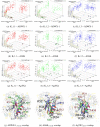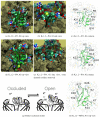Developing a comparative docking protocol for the prediction of peptide selectivity profiles: investigation of potassium channel toxins
- PMID: 22474570
- PMCID: PMC3317111
- DOI: 10.3390/toxins4020110
Developing a comparative docking protocol for the prediction of peptide selectivity profiles: investigation of potassium channel toxins
Abstract
During the development of selective peptides against highly homologous targets, a reliable tool is sought that can predict information on both mechanisms of binding and relative affinities. These tools must first be tested on known profiles before application on novel therapeutic candidates. We therefore present a comparative docking protocol in HADDOCK using critical motifs, and use it to "predict" the various selectivity profiles of several major αKTX scorpion toxin families versus K(v)1.1, K(v)1.2 and K(v)1.3. By correlating results across toxins of similar profiles, a comprehensive set of functional residues can be identified. Reasonable models of channel-toxin interactions can be then drawn that are consistent with known affinity and mutagenesis. Without biological information on the interaction, HADDOCK reproduces mechanisms underlying the universal binding of αKTX-2 toxins, and K(v)1.3 selectivity of αKTX-3 toxins. The addition of constraints encouraging the critical lysine insertion confirms these findings, and gives analogous explanations for other families, including models of partial pore-block in αKTX-6. While qualitatively informative, the HADDOCK scoring function is not yet sufficient for accurate affinity-ranking. False minima in low-affinity complexes often resemble true binding in high-affinity complexes, despite steric/conformational penalties apparent from visual inspection. This contamination significantly complicates energetic analysis, although it is usually possible to obtain correct ranking via careful interpretation of binding-well characteristics and elimination of false positives. Aside from adaptations to the broader potassium channel family, we suggest that this strategy of comparative docking can be extended to other channels of interest with known structure, especially in cases where a critical motif exists to improve docking effectiveness.
Keywords: HADDOCK; Kv1.1; Kv1.2; Kv1.3; comparative docking; protein-protein docking; scorpion toxins; selectivity; α-KTx.
Figures








Similar articles
-
Interaction of agitoxin2, charybdotoxin, and iberiotoxin with potassium channels: selectivity between voltage-gated and Maxi-K channels.Proteins. 2003 Aug 1;52(2):146-54. doi: 10.1002/prot.10341. Proteins. 2003. PMID: 12833539
-
Brownian dynamics simulations of the recognition of the scorpion toxin maurotoxin with the voltage-gated potassium ion channels.Biophys J. 2002 Nov;83(5):2370-85. doi: 10.1016/S0006-3495(02)75251-X. Biophys J. 2002. PMID: 12414674 Free PMC article.
-
The 'functional' dyad of scorpion toxin Pi1 is not itself a prerequisite for toxin binding to the voltage-gated Kv1.2 potassium channels.Biochem J. 2004 Jan 1;377(Pt 1):25-36. doi: 10.1042/BJ20030115. Biochem J. 2004. PMID: 12962541 Free PMC article.
-
Diverse Structural Features of Potassium Channels Characterized by Scorpion Toxins as Molecular Probes.Molecules. 2019 May 29;24(11):2045. doi: 10.3390/molecules24112045. Molecules. 2019. PMID: 31146335 Free PMC article. Review.
-
Potassium channel blockers from the venom of the Brazilian scorpion Tityus serrulatus ().Toxicon. 2016 Sep 1;119:253-65. doi: 10.1016/j.toxicon.2016.06.016. Epub 2016 Jun 25. Toxicon. 2016. PMID: 27349167 Review.
Cited by
-
New High-Affinity Peptide Ligands for Kv1.2 Channel: Selective Blockers and Fluorescent Probes.Cells. 2024 Dec 18;13(24):2096. doi: 10.3390/cells13242096. Cells. 2024. PMID: 39768187 Free PMC article.
-
Structural basis of the selective block of Kv1.2 by maurotoxin from computer simulations.PLoS One. 2012;7(10):e47253. doi: 10.1371/journal.pone.0047253. Epub 2012 Oct 10. PLoS One. 2012. PMID: 23071772 Free PMC article.
-
Complexes of Peptide Blockers with Kv1.6 Pore Domain: Molecular Modeling and Studies with KcsA-Kv1.6 Channel.J Neuroimmune Pharmacol. 2017 Jun;12(2):260-276. doi: 10.1007/s11481-016-9710-9. Epub 2016 Sep 17. J Neuroimmune Pharmacol. 2017. PMID: 27640211
-
Computational study of aggregation mechanism in human lysozyme[D67H].PLoS One. 2017 May 3;12(5):e0176886. doi: 10.1371/journal.pone.0176886. eCollection 2017. PLoS One. 2017. PMID: 28467454 Free PMC article.
-
Molecular Simulations of Disulfide-Rich Venom Peptides with Ion Channels and Membranes.Molecules. 2017 Feb 27;22(3):362. doi: 10.3390/molecules22030362. Molecules. 2017. PMID: 28264446 Free PMC article. Review.
References
-
- Mouhat S., Andreotti N., Jouirou B., Sabatier J.M. Animal toxins acting on voltage-gated potassium channels. Curr. Pharmaceut. Des. 2008;14:2503–2518. - PubMed
-
- Norton R., Pennington M., Wulff H. Potassium channel blockade by the sea anemone toxin ShK for the treatment of multiple sclerosis and other autoimmune diseases. Curr. Med. Chem. 2004;11:3041–3052. - PubMed
-
- Judge S., Bever C. Potassium channel blockers in multiple sclerosis: Neuronal K-V channels and effects of symptomatic treatment. Pharmacol. Therapeut. 2006;111:224–259. - PubMed
Publication types
MeSH terms
Substances
LinkOut - more resources
Full Text Sources

